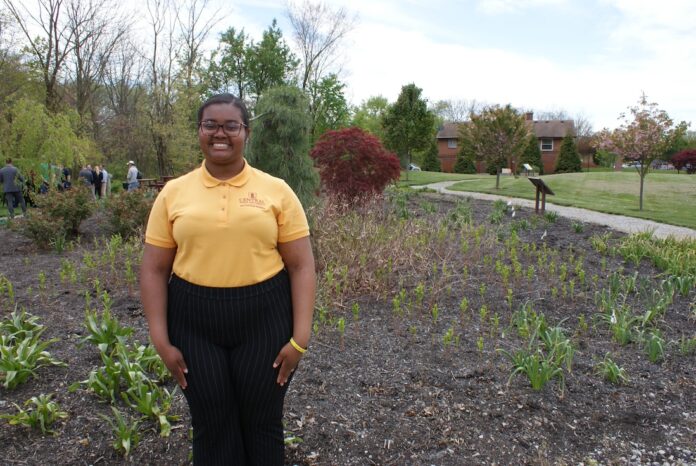
WILBERFORCE, Ohio — Standing behind a table featuring African heritage crops, Detroit native Mariah Simmons, a junior pre-law major at Central State University, talked about her fascination with agriculture.
“Kids of color from the north don’t know about gardening,” she said. “I want to learn more and help educate others.”
Inspiring a new generation of agricultural researchers and professionals is just one of the new programs underway at Central State University, which celebrated 10 years of land-grant status at their second annual Open House on April 26.
Activities
A circus-sized tent graced the lawn on a warm, spring day where hundreds of visitors interacted with lunchtime exhibits and listened to speakers following morning tours of campus research labs.
The afternoon culminated in an Arbor Day tree planting with help from Ohio Gov. Mike DeWine, commemorating the 75th anniversary of the Ohio Department of Natural Resources.
Under the tent, Simmons shared information about collard greens, black-eyed peas and okra, a few of the culturally specific African crops she is studying. She spent the school year in the lab and will spend her summer working at the Seed to Bloom Botanical Garden, part of Central State’s Agricultural Production Area. Her experience with gardening has given her a new perspective for her future career.
“I plan to specialize in agricultural law,” Simmons said.
The project, sponsored by a Sustainable Agriculture Research and Education grant, is looking at the viability and sustainability of the crops in Ohio climates and soil types.
Successful production of these crops may allow Ohio farmers to market and profit from them, according to project director Clare Thorn, extension associate of agriculture and natural resources at Central State.
Training new agricultural professionals
At the Bee Lab, Central State’s entomologist Hongmei Li-Bayarly showcased her research program in pollinator health. Her lab studies genetics and molecular-level causes of social behavior in honeybees. They are using a new piece of equipment called the Chromium Connect 10X Genomics — reported to be the only one in Ohio — which automates workflows in studies concerning single cells from organisms.
“Bees are critical as pollinators for food production,” Li-Bayarly said. “Their behavior is fascinating to study. They’re eusocial insects like ants and termites, also, called super organisms.”
Even though Li-Bayarly grew up in a city in China about the size of Chicago, she spent summers in the country at her grandparent’s house, “playing with her cousins and chasing bugs.”
“I’m a country girl at heart,” she said.

In addition to her work with honeybees, Li-Bayarly is inspiring the next generation of agriculture professionals as principal investigator of the NEXTGEN project, “Cultivating the Next Generation of Diverse Food and Agriculture Professionals.”
The four-university partnership received a $10 million award from the U.S. Department of Agriculture.
“The grant provides training opportunities and research internships for students to explore topics in agriculture, especially in soil science, entomology and life sciences,” she said.
The other three universities in the partnership include Texas A&M University, the Missouri University of Science and Technology and Lincoln University, also in Missouri.
The four Cs of the land-grant mission
Keynote speaker Dr. Manjit Misra, who serves as director of the USDA National Institute of Food and Agriculture, said the university’s land-grant status allows CSU to better serve society.
“For most of its history, Central State was focused on service,” he said, during his remarks.
Misra “fell in love” with the land-grant mission while he was a student in Missouri. He sees that mission in the funding opportunities now available to CSU.
The first ‘C’ is capacity building: New funding has help add research faculty, staff and equipment along with support for students at the university. The second ‘C’ is collaboration, the key to solving the challenges facing society today. Next, is cultivation. He spoke of “cultivating future leaders through diversity and equity.”
“I’m a seed scientist,” he said. “Seeds have different shapes, sizes, textures, luster and colors and there is life in each seed. Just like people. We have different skin or hair, we are tall or short, but in each of us there is the voice that says, ‘Do your best.’ We all want to solve problems.”
The final ‘C’ is communication. “Researchers are focused on data, but that isn’t enough,” Misra said. The Bill Gates Foundation once provided medications for developing nations, but realized medicine isn’t enough. To create a healthy population, agriculture is key. Food and health are interconnected.
“Investing in agriculture is an investment in economic development,” he said.










